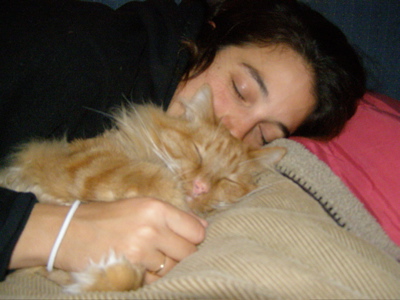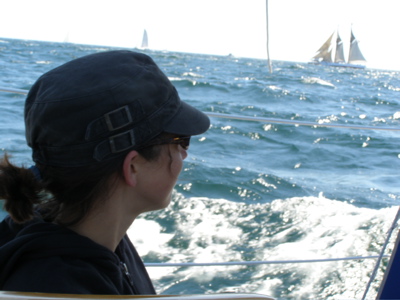I am a confident and prudent sailor. I know my limitations and strengths and pursue ventures within my abilities, which is why I decided to wait for a few days before my first solo sail on my own boat. The weather radio was indicating that a small craft warning was “in effect.” They predicted weather that I have competently sailed in before, but my anxiety was heightened by the perception that my very own boat was somehow more delicate and susceptible to damage than all the other boats I have sailed. So I waited an extra day, and then another.
During the days that I waited, I worried and wondered if I would be ok sailing alone, I raised and lowered my sails, reefed them, secured my bike and sails on the deck, stowed my belongings for sea, and cleaned out the icebox and lockers. Then, I reorganized again, checked the fuel level, and proceeded to tinker with every little detail that could be a concern, while trying to get a good night sleep each night.

Finally, at 0530 on Thursday morning, I was on my way. I cast off my lines and pulled away from the dock, a strong current pushing me along. Exiting the river where I was moored requires you to pass under two bridges. As I approached the first, I hailed the bridge tender, “Main Street River bridge, Main Street River bridge, Main Street River bridge,” I said three times as is the radio protocol, “This is the sail vessel Daphne. Over.”
I waited. No reply.
I tried again. “Main Street River bridge, Main Street River, bridge, Main Street River bridge. This is the sail vessel Daphne. Over.”
Still no reply.
After a third try I was growing concerned. I was at the bridge and had been circling around for a while already, wondering if I was going to be allowed through. Finally, someone replied, “Sail vessel, Daphne. Try channel one three.” I switched to channel thirteen and shortly after the bridge was opened.
Once out of the river I had plenty of wind to set my sails. I set the full main and a working jib, and sailed along nicely for quite a while. There were no problems, manageable boat traffic, and the skies were clear. I spent that time playing with the video camera that Benji loaned to me (video footage soon to be posted on this blog), reading books, cooking, and fighting off seasickness.
The boat was rolling gunwale to gunwale, the lest ideal conditions for keeping your head from spinning. The only thing that could make it worse was the fog that came later that day. The swells coming in from the open ocean were and causing me to become queezy. My only solace being stale bread and the occasional healthy belch, which always seems to sooth the nauseousness for a brief moment. Then, my luck turned and the fog rolled in. Sometimes the fog will burn off as quickly as it rolls in, but this fog would stay with me for my entire trip.
As the fog rolled in, the wind quietly abated until there was nothing left, and I was bobbing about in the ocean, rolling from side to side, land nowhere in sight. I had two choices, either I continue like this and wait for wind, or I turn on my engine. Faced with this decision to be made, I considered what time it was, how many miles I had left to travel, and when the sun was setting. I didn’t want to get to my anchorage in the night, especially with the fog added as a double blindfold. So, I turned on the engine and pressed on.
I approached my anchorage as the sun was starting to set and I was getting more and more nervous. I had about twenty minutes of twilight left and I pushed the throttle ahead more. I was on edge. I stood in the cockpit, and scanned the horizon looking for the lighted buoys, then plotted a position on the chart, looked at the depth sounder to make sure I wasn’t too close to the land that was to my port (yet I couldn’t see), and scanned the horizon again. This continued for what seemed like far too long. Scanning, plotting, waiting, checking, scanning, plotting, checking, scanning. Until finally I could hear the horn at the southern edge of the Point. Soon I would be able to see its light. All I had to do was keep it to my left as I curled around the cape, and use my depth sounder to ensure that I didn’t get too close to land. I would know when I arrived at my anchorage when I could her, or see one light to the south, one to the north, and the lights from the town to the northeast. Using these landmarks and my hand-bearing compass, I could plot my exact position.

When I first began sailing I didn’t have access to a GPS, radar, depth sounder, or any other electronic navigational equipment. I learned to navigate the traditional ways, using a chip log, lead line, compass, rulers, triangles, chart, and dividers. I think its fantastic how effective and simple these tools are, tools that were used long before the development of the electronics that are used today.
These are the tools that were used when a sailor carried a compass around his neck, a knife and marlinspike on his belt, and a ration of grog in his sea duffle. It’s the beauty of that simplicity that continues to draw me to sailing. How wonderful it is to harness Earth’s wind to propel me, her magnetic forces to direct me, and the songs of the tides and gulls to sooth me.
I remember a time when I was studying for the Coast Guard Captain’s License exam with a few friends, who brought along a few other friends. I was the only sailor of small boats amongst the group. Most of them sailed larger vessels with all the newest technologies. Most of them “sailed” powerboats.
They joked about my experience and scoffed at me…a small boat sailor, a row boat sailor…becoming a Captain! But when the time came to take the navigation exam, I walked away with a 100% and was on my way home while others were still waiting for their opportunity to retake it. I’m thankful for my traditional navigation skills. Someday the electronics will fail and I’ll have to find my way without them. So, even though I now have a GPS, I still double check its accuracy using a simple compass and rulers, which is just what I did when I arrived at my anchorage. (…to be continued)
Click HERE to read Part Two!
Click HERE to read Part Three!


Comments 13
Much of my sailing experience was without motor, which was ok and taught some valuable sailing lessons, but being becalmed definitely made for hard sailing. It is good to be able to start the engine in those times, were fatigue or arriving in daylight can be an issue.
Author
Yes Stuart! I agree. Much of my sailing experience was without a motor or any electronics. I loved those experiences, and they better prepare me for times when things go wrong and gadgets fail.
I’d much rather sail with someone who’s learned ‘the hard way’ as opposed to someone who’s always relied on electronics. My fiance learned how to sail as a teenager and by the time he was 16 he was an instructor. Just last year he took and passed the Coast Guard Captain’s test and I was so excited for him. I myself am not a sailor and never will be in a technical way because it just doesn’t come naturally to me, but I do my best and I love being on the water with Hans. And as for anchoring in the evening? No thanks, been there done that!
Teresa,
Your blog is inspiring, and a welcome catalyst to my own adventurous spirit. If I did not have bold role models like yourself to read about, I wonder if I would still be discontent with my current lifestyle. The boat of my dreams is to be surveyed this Thursday. The plan is to move aboard as soon as possible, graduate from college, then set sail for bluer water and a more natural lifestyle. Untethered from THINGS, I hope to learn what living is really all about.
I have even been toying with the idea of selling my beloved Jeep Wrangler. The thought is terrifying to me, but perhaps that is a testament to how much I need to let it go. Can it be healthy to be so attached to a machine? I should have confidence in my ability to get by without it, but it is a scary thought nonetheless.
Anyway, Please keep blogging, your words fuel the fire that propels me toward the nebulous goal of simplicity… Maybe I’ll get there someday 🙂
austin
Hi Teresa, Just wondered if you have any interest in the art and science of celestialnavigation?,I took it many years aqo in nautical college, and a refresher last year in Mystic Seaport. The method is by HO229(the sight reduction tables)and the Nautical Almanac.It is also possible to learn just enough to find your latitude,either by shooting the sun at noon (latitude by LAN,or by shooting POLARIS.In any event it is a good skill to learn,in case the black boxes fail.Be well Mark S/V GYPSY 1976 WESTSAIL 28
Author
@Mark
Yes! I would love to learn Celestial. I enjoy very much traditional navigation and all things geometry. Perhaps thats why I fell into costume pattern making as well! So much fun. I took a celestial course, but still have much to learn. I’ll learn it as I go for now.
@Austin
You are lucky to be fresh from college and already ready to buy a boat. I wish I did it then. I’ll be even more jealous if you don’t need to take out a loan! Thats awesome. Perhaps we will meet on the blue.
I too used to sail with no electrical, electronics or engine.
My boat was a piece of junk so it all broke regularly.
Got a better boat now. Lived aboard now for 17 years.
Cuba is nice this time of year! With Bush gone it is probably doable again.
Pingback: My First Solo Sail (part two)
Pingback: My First Solo Sail (part three)
Great blog!
Theresa,
As Doug and I kayacked around the harbor today, we came across the Daphne and you. (Didn’t see the cat.) It was a delight talking with you and hearing of your dream, one we were convinced was eminently achievable. I don’t know that we’ll make it to your restaurant (haven’t had a good experience there since it opened), but we’ll check in with your blog occasionally.
If you check this tonight, we’re looking for a sailing experience tomorrow. Let us know what you know and what you’ve got!
All the best,
George
george@minding.org
Now THAT’S a cool boat! 🙂
Like a Beginner, I’m always looking on line for content that may help me. Thank you